
1. America's Second Industrial Revolution
1.1. Railways
1.1.1. Transcontinental Railroad
1.2. Steel
1.2.1. Bessemer Process (molten pig iron)
1.3. Communications
1.3.1. Samuel Morse (developed telegraph)
1.3.2. Cyrus Field (Transatlantic Cable)
1.3.3. Alex Graham Bell (Telephone)
1.3.4. Thomas Edison (Phonograph/ Electric Lightbulb)
1.3.5. Nicola Tesla (Radio waves)
1.4. Oil
1.4.1. Edwin Drakes oil well
1.4.2. Petroleum and Gasoline
1.5. Transportation
1.5.1. Henry Ford (affordable automobile)
1.5.2. Wright Brothers (airplane)
1.5.3. Internal combustion engines
1.6. Entrepreneurs
1.6.1. John D. Rockefeller (standard oil)
1.6.2. Andrew Carnegie (Union Railroads and steel)
1.6.3. J.P Morgan (J.P. Morgan and Company)
2. Early Government Regulation of Business
2.1. Munn v. Illinois (regulation of business affecting public interests)
2.2. Wabash v. Illinois (states could not regulate interstate commerce)
2.3. Interstate Commerce Act (prohibited unfair practices by railroads)
2.4. Sherman Antitrust Act (forbade limitations on interstate trade)
2.5. U.S. v. Knight Company (Sherman Antitrust Act could not be used to break a monopoly controlling over 90% of all U.S. sugar refining)
3. Emergence of Big Businesses
3.1. Monopoly (wholesome control over the production of a good or service)
3.2. Pooling agreements (informal agreements to fix prices on a regional basis)
3.3. Trusts
3.4. Holding company (owned a controlling number of shares in other companies)
4. Robber Barons
5. Factors for economic growth
5.1. Abundant Natural Resources
5.2. Free Enterprises
5.2.1. Capitalism: private ownership
5.2.2. Market Economy
5.2.3. Social Darwinism (survival of the fittest)
5.3. The Role of Governments
5.3.1. Laissez-faire (little government intervention)
5.3.2. Patent System

